Effective Strategies for Bed Bug Removal from Skin
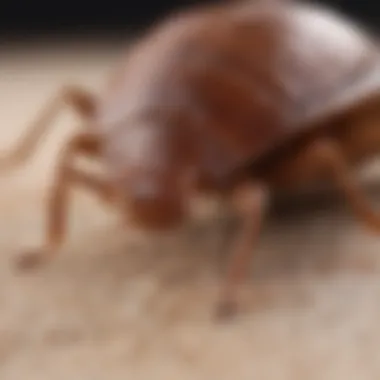

Intro
Dealing with bed bugs is a prevalent concern for many people, and it necessitates a careful approach to effectively remove them from one's body and living environment. This guide aims to provide clear and practical solutions for eliminating these pests. It will delve into various strategies that can help manage infestations, emphasizing both direct and preventive methods. Understanding the habits and biology of bed bugs can improve the effectiveness of these techniques and offer a pathway toward a bug-free life.
Key Insights and Trends
While the world of pest control may not seem to trend in the same way as interior design or gardening, there are emerging insights into the methods and practices for managing bed bug infestations. Awareness of bed bug behavior is increasing, leading to better preventive measures.
- Awareness Campaigns: Communities are becoming more active in spreading knowledge about bed bugs. Educational programs illustrate the importance of regular inspections and early detection.
- Rise of Natural Remedies: There is a growing interest in non-toxic solutions, such as diatomaceous earth and essential oils, as alternatives to traditional pesticides for removing bed bugs from the body and home.
This evolving understanding is vital for any homeowners concerned about infestations.
Practical Tips and How-To Guides
Removing bed bugs from the body may require a multi-faceted approach, blending personal hygiene with environmental controls. To aid in this endeavor, here are some actionable steps:
- Personal Hygiene
- Clothing Care
- Home Environment
- If Infestation Persists
- Wash affected areas with hot, soapy water. This helps remove bugs or eggs.
- Use an exfoliating scrub to ensure your skin is clean and free of residues.
- Shower daily to minimize the chance of bugs remaining on your body.
- Wash clothing in hot water and dry on the highest cycle. This effective method can kill any lingering pests.
- Store clean clothes in sealed bags to prevent re-infestation.
- Vacuum thoroughly and regularly. Focus on bedroom areas, including mattresses and bed frames.
- Consider using mattress encasements specifically designed to trap bed bugs.
- Consult pest control professionals, especially if over-the-counter solutions are ineffective. Their expertise can be crucial in dealing with severe infestations.
"Prevention is better than cure." Effective measures will save you time and stress in the long run.
By incorporating these strategies, individuals can effectively tackle bed bug situations and reduce their risks. Awareness, hygiene, and proactive measures will contribute to a more effective management plan.
Understanding Bed Bugs
Understanding bed bugs is crucial for effectively managing their presence both on the body and in living spaces. These pests are small yet resilient, making them a common issue for many households and individuals. Recognizing their biology and behavior aids in crafting suitable strategies for removal and prevention. It’s not just about eradicating the current infestation; it’s also essential to comprehend how these insects operate to prevent further occurrences.
Biology of Bed Bugs
Bed bugs, scientifically known as Cimex lectularius, are small insects that belong to the family Cimicidae. They are approximately 4 to 5 mm in length, oval-shaped, and usually brownish in color. Their coloration can change to a reddish hue post-feeding. One of their most striking characteristics is their ability to reproduce rapidly. Female bed bugs can lay hundreds of eggs in their lifetime, which complicates eradication efforts.
Bed bugs feed exclusively on blood, typically preferring human blood, although they can feed on other warm-blooded animals. Their feeding process involves injecting saliva, which contains anticoagulants to facilitate blood flow. This is also what causes the common allergic reaction found in many individuals after a bite.
These insects can survive several months without feeding, thus making them particularly difficult to eliminate completely. Their ability to hide in cracks and crevices further emphasizes the need for a detailed understanding of their biology.
Behavioral Patterns
Bed bugs exhibit distinct behavioral patterns that are essential for recognizing and managing infestations. They are nocturnal creatures, mostly active during the night when their hosts are asleep. During this time, they venture out from their hiding places to feed.
They prefer to stay close to their host's sleeping areas—commonly found in mattresses, bed frames, and furniture. However, they can also travel significant distances if necessary, seeking new hosts as needed.
Another important aspect is their reaction to environmental stimuli. Bed bugs are attracted by warmth and carbon dioxide, which helps them locate hosts. They tend to congregate in large numbers when an area is suitable; thus, an initial finding of one can often indicate a larger problem.
Important Note: Understanding the biology and behavior of bed bugs not only aids in identifying them but also assists in creating specific and effective removal strategies.
Identifying Bed Bug Bites
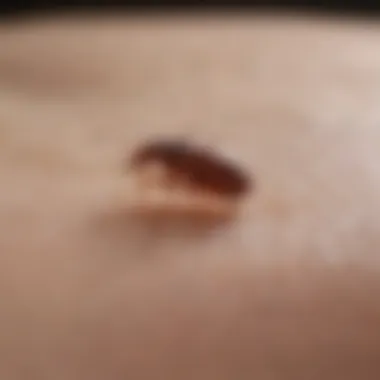

Identifying bed bug bites is crucial in managing infestations. Early recognition can significantly reduce the spread of these pests and the associated discomfort from their bites. Bed bug bites can often appear similar to those of other insects, leading to confusion and misdiagnosis. Therefore, understanding their characteristics helps in taking appropriate action quickly.
Characteristics of Bed Bug Bites
Bed bug bites typically present as small, red welts on the skin. They often have a dark center surrounded by a lighter red area. One of the distinctive features of these bites is their tendency to appear in a linear or clustered pattern. An individual may notice several bites in close proximity, which is a telltale sign.
These bites usually itch, which can lead to scratching and possible secondary infections. It's important to note that some people may not show immediate signs of a bite, while others might experience an allergic reaction that causes severe itching or swelling. Moreover, the bites usually occur at night when bed bugs are most active, which can help individuals link the bites to a potential bed bug issue.
Distinguishing from Other Insect Bites
Identifying bed bug bites requires distinguishing them from bites caused by other insects. For instance, mosquito bites are generally more isolated and less clustered than those of bed bugs. Additionally, mosquito bites tend to be raised and may present a small blister in some cases.
Flea bites usually occur on the lower legs and may appear in groups of three or more, while bed bug bites can appear anywhere on the body. Spider bites typically have a more pronounced center and may cause necrosis in some cases. Therefore, observing the location, pattern, and timing of the bites helps determine their origin.
Recognizing these differences not only aids in identifying the source of discomfort but also helps in formulating an effective response. Understanding the characteristics of bed bug bites can lead to quicker interventions that may include physical removal techniques or seeking professional help if needed.
"It is essential for individuals to educate themselves about the specifics of bed bug bites to manage any risk effectively."
In summary, knowing how to identify bed bug bites is a fundamental step in dealing with these pests. It further enables homeowners and others affected to make informed decisions regarding treatment and prevention strategies.
Methods to Remove Bed Bugs from the Skin
The removal of bed bugs from the skin is a critical aspect of managing an infestation. Understanding how to effectively address the issue not only aids in immediate relief but also helps prevent further complications, such as secondary infections and persistent itching. Various methods can be deployed to remove bed bugs and alleviate symptoms. Key elements to consider include identifying effective physical removal techniques, the application of topical treatments, and the utilization of natural remedies, each serving a distinct purpose in a comprehensive strategy.
Physical Removal Techniques
Physical removal techniques focus on the immediate extraction of bed bugs from the skin. It is essential to act promptly to minimize irritation and potential allergic reactions. Here are some practical methods:
- Manual Removal: Use a pair of clean tweezers to gently grasp any visible bed bugs. It is crucial to avoid squashing them, as they can release pheromones that warn others.
- Washing: Take a warm shower immediately. This can help dislodge bed bugs and soothe itchy skin. A gentle scrub can aid in physical removal without causing skin damage.
- Pat Dry: After showering, pat the skin dry with a clean towel instead of rubbing. This reduces irritation and ensures any remaining bed bugs are removed without harming the skin further.
These techniques should be conducted carefully to avoid scratching the skin, which can lead to infections.
Using Topical Treatments
Topical treatments are an effective means of managing itching and preventing secondary complications. Here are notable options:
- Hydrocortisone Cream: This over-the-counter option can reduce inflammation and itchiness. Application should be done sparingly and according to instructions.
- Antihistamines: Creams containing ingredients like diphenhydramine can alleviate allergic responses to bites.
- Antiseptic Lotion: Products containing benzalkonium chloride can help in cleaning the bite area, thus reducing the chances of infection.
The choice of treatment should align with individual skin sensitivities and specific reactions to bed bug bites. Always refer to a healthcare professional for guidance if reactions are severe.
Natural Remedies
Natural remedies can also aid in the relief of symptoms and help to manage bed bug infestations effectively. These remedies are often more accessible and less invasive:
- Tea Tree Oil: Known for its antiseptic properties, tea tree oil can be diluted with carrier oil and applied to affected areas to reduce irritation.
- Aloe Vera: This plant is renowned for its soothing properties. Applying fresh aloe vera gel can alleviate discomfort and promote healing of the skin.
- Oatmeal Baths: Soaking in a bath with colloidal oatmeal can provide significant relief from itching and irritation caused by bites.
Incorporating these natural substances into a regular skin-care routine might mitigate the effects of bed bug bites effectively.
Bed bugs, while being a nuisance, are manageable. A synthesis of physical, topical, and natural approaches creates a comprehensive strategy for addressing their presence on the body. Always monitor for any signs of allergic reactions and consult with professionals as needed.
"Addressing potential bites promptly can help minimize discomfort and prevent further complications."
Environmental Control and Prevention
Understanding environmental control and prevention methods is critical in managing bed bug infestations. By addressing the conditions that allow these pests to thrive, one can significantly reduce the risk of experiencing direct contact with bed bugs on the body. Effective control strategies extend beyond immediate removal techniques, providing a proactive stance in the battle against these resilient insects.
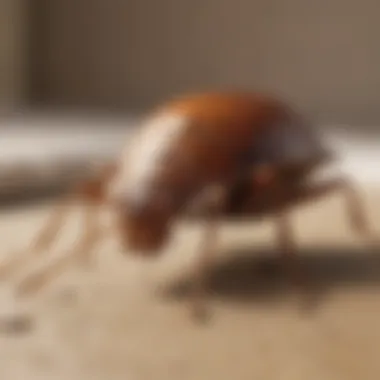
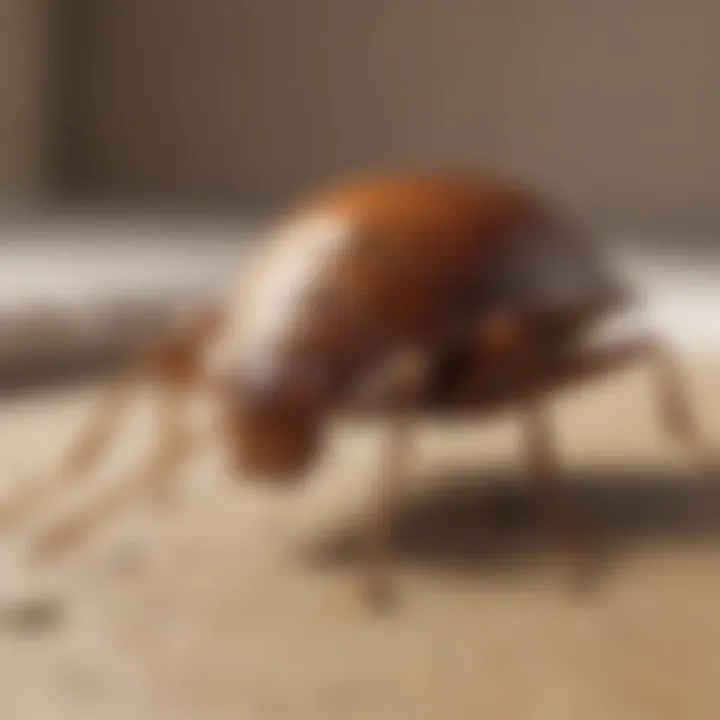
Assessing Potential Infestation Areas
Thorough examination of potential infestation areas is the first step to preventing bed bugs. Common places to check include:
- Bedrooms: Inspect mattresses, bedsheets, and box springs thoroughly, as bed bugs often hide in these areas.
- Furniture: Look behind and under couches, chairs, and decorative pieces, as these are also favored hiding spots.
- Luggage: Check bags and suitcases, particularly after traveling. Bed bugs can latch onto clothing and travel undetected.
- Electronics: Electronics can harbor these pests, so inspecting gadgets is crucial.
Utilize a flashlight for better visibility in dark areas. Regular checks ensure that any signs of bed bugs are caught early, greatly reducing the chance of significant infestation.
Effective Cleaning Practices
Cleaning your living space thoroughly is another critical element in preventing bed bugs. Implement practices such as:
- Vacuum Regularly: Utilize a vacuum with a HEPA filter to minimize allergens and collect any potential bed bugs. Focus on carpets, rugs, and crevices where bed bugs may hide.
- Wash Bedding Frequently: Wash bed linens in hot water and dry them on a high heat setting. This can kill any bed bugs and eggs present.
- Declutter: Remove unnecessary items from your home. Reducing clutter minimizes hiding spots for bed bugs.
- Seal Cracks and Crevices: Inspect walls and furniture to seal any areas where bed bugs could enter or hide.
These practices are not only effective in reducing the risks of infestations but also improve overall hygiene in the living space.
Utilizing Insecticides Wisely
When faced with an infestation, it may be necessary to employ insecticides. However, it is essential to use them carefully.
- Choose the Right Product: Select insecticides specifically labeled for bed bugs. Products containing pyrethroids and neonicotinoids can be effective.
- Follow Instructions: Always adhere to the application instructions on the label. Using more than recommended can be hazardous.
- Target Areas Carefully: Focus on areas known to harbor bed bugs, such as seams of mattresses and behind furniture, avoiding over-spraying in living areas.
- Consider Professional Help: If the infestation is severe, consulting pest control professionals ensures that insecticides are applied correctly and safely.
By combining thorough cleaning with wise use of insecticides, one can create an inhospitable environment for bed bugs, making it difficult for them to survive and thrive.
Health Considerations
Understanding health considerations when dealing with bed bugs is crucial. Bed bugs are not only a nuisance but also have the potential to trigger various health issues. It is essential to recognize how infestations can impact both physical and mental well-being. Addressing these health concerns allows individuals to take appropriate action, improving their overall quality of life.
Allergic Reactions and Skin Conditions
When bed bugs bite, they inject saliva that can cause allergic reactions in susceptible individuals. The reaction can manifest in different ways, ranging from mild to severe. Common symptoms include redness, itching, and swelling at the bite site. In some cases, these bites can lead to the development of skin infections, particularly if the affected area is scratched excessively. Maintaining proper hygiene and safeguarding the skin can alleviate these issues.
Allergic reactions may also cause systemic symptoms in specific individuals, such as nausea or headaches. It is noteworthy that the severity of the reaction varies widely among people. Here are some precautionary steps to consider:
- Recognize symptoms early: Monitor for any allergic reaction following a bed bug bite.
- Avoid scratching: This helps prevent secondary infections.
- Consult a healthcare provider: Seek professional advice if symptoms worsen or spread.
"Prompt attention to health considerations related to bed bugs can mitigate long-term effects on well-being."
Psychological Effects of Bed Bug Infestations
Beyond the physical implications, the psychological effects of bed bug infestations are profound. Living with the knowledge that bed bugs may be present can result in significant stress and anxiety. Many individuals experience insomnia, as the fear of being bitten can disrupt sleep patterns. This ongoing stress can contribute to broader mental health challenges, such as depression or heightened anxiety levels.
It's also common for people to feel ashamed about an infestation, leading to social withdrawal. The stigma attached to having a bed bug issue can exacerbate feelings of isolation. To cope effectively, consider these strategies:
- Stay informed: Understand the facts surrounding bed bugs, which can reduce fear.
- Seek support: Engage with friends or support groups to address feelings of isolation.
- Consult mental health professionals: They can provide coping strategies for managing the emotional burden.
Addressing both allergic reactions and psychological implications is vital in creating an environment where recovery can thrive. Managing health considerations holistically helps in confronting and ultimately overcoming infestations.
When to Seek Professional Help
Dealing with bed bugs can be a challenging experience. While some infestaions may be manageable through DIY methods, knowing when to seek professional help is vital. In this section, we will explore the key indicators that suggest it may be time to involve pest control experts, as well as the benefits of doing so.
Signs of Severe Infestation
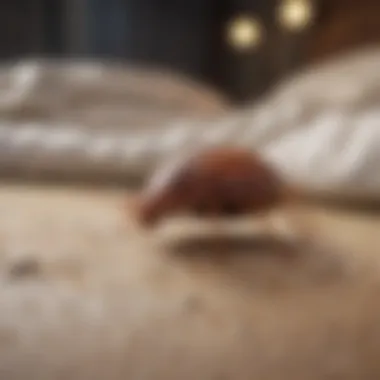

Recognizing the signs of a serious bed bug infestation is crucial. Here are some key indicators that you may need professional help:
- High frequency of bites: If you find that you are consistently waking up with multiple bites, it may indicate a larger population.
- Visible bed bugs: If you see bed bugs crawling on your mattress, bedding, or furniture, it suggests a severe presence.
- Fecal stains: Bed bugs leave droppings that appear as small, dark spots on sheets, walls, or furniture. A significant amount of these stains indicates a need for help.
- Skin reactions: Severe allergic reactions or infections from bites that do not heal can be a sign of a persistent infestation.
- Difficulty in managing: If your own methods have failed after several attempts, it is time to consider professionals.
These signs indicate an infestation that is beyond the capacity of self-treatment.
Choosing a Pest Control Service
Once you decide to seek help, choosing the right pest control service is essential. Here are some considerations:
- Research Experience: Look for services with a proven track record in dealing with bed bugs specifically. Check reviews and ask for references.
- Inspection Procedures: A responsible service should offer a thorough inspection to assess the level of infestation. They should also explain the steps they plan to take.
- Treatment Options: Inquire about the methods they use. Effective treatments can include heat, chemical sprays, and vacuuming. Choose a service that uses safe and effective approaches.
- Follow-up Services: Ask if they provide follow-up evaluations to ensure the infestation is completely eradicated. Continuous monitoring can prevent re-infestation.
- Cost Transparency: Get quotes and understand all costs involved upfront. Compare offers while being cautious of prices that seem too good to be true.
"Choosing a qualified pest control service can be the difference between a temporary solution and a long-term fix."
These steps can help you find a reputable service, ensuring a healthier living environment free from bed bugs.
Case Studies and Real-Life Experiences
Understanding real-life situations involving bed bugs is crucial for creating effective strategies in their management. Case studies provide a unique lens through which homeowners and pest control professionals can observe the dynamics of bed bug infestations. They reveal patterns in how infestations spread and the varying approaches to eradication. Importantly, these stories take theory into practical application, allowing individuals to learn from the challenges others faced and the solutions that worked.
Successful Eradication Techniques
Successful case studies often highlight several key techniques for effectively removing bed bugs from the body and the environment. Most notably, various methods can be employed simultaneously for better results.
- Physical Exclusion: Many case studies emphasize the importance of thorough physical removal processes. Simple actions like washing infested clothing in hot water and vacuuming areas have proven to aid in reducing bed bug presence.
- Topical Treatments: In some scenarios, individuals have reported the use of medical-grade topical treatments after physical removal. Products like hydrocortisone cream have been noted in various experiences, providing relief from discomfort.
- Natural Remedies: There are numerous reports of individuals using essential oils, such as tea tree oil, to repel or irritate bed bugs. While the efficacy may vary, inclusion of herbal solutions deserves consideration if you prefer a more holistic approach.
Lessons Learned from Infestation Stories
Many lessons can be collected from those who have faced bed bug infestations. These stories are valuable resources that can serve as guidelines for others. Some of the major takeaways include:
- Awareness is Key: Identifying bed bugs quickly is essential. Many individuals who experienced prolonged infestations did not recognize the signs early. This underlines the significance of education regarding how to identify both bed bugs and their bites.
- Comprehensive Approach: A common thread among successful eradication accounts is the necessity of a multi-faceted strategy. Relying solely on one method, such as insecticides, often resulted in failure. Coordinating various techniques gives a greater chance to fully eliminate the problem.
- Consult Professionals: Several case studies illustrate the benefits of involving pest control agencies when faced with severe infestations. While homeowners may attempt to treat the issue independently, sometimes outside help can deliver more effective results through specialized knowledge and equipment.
In summary, the realities of dealing with bed bugs can provide deep insight. By analyzing successful eradication techniques and learning from the pitfalls of others, future infestations might be managed more effectively. Reading about these experiences fosters a proactive approach, equipping readers with both knowledge and practical steps to act efficiently.
Ending and Future Considerations
Effective management of bed bugs requires a comprehensive approach. This article emphasizes the importance of ongoing prevention. Continuous vigilance is key in stopping potential infestations before they can take root. Homeowners, interior design enthusiasts, and party hosts should prioritize their living spaces.
The Importance of Ongoing Prevention
Preventative measures are paramount in avoiding the disruption caused by bed bugs. Regular inspections of sleeping areas, luggage, and upholstered furniture can catch early signs of infestations. Simple tasks, like washing bedding in hot water, can reduce the risk significantly.
Tips for ongoing prevention include:
- Seal cracks and crevices in walls and furniture to limit hiding spaces.
- Maintain cleanliness by vacuuming regularly, focusing on seams and crevices.
- Use protective covers for mattresses and pillows. These can reduce contact and entry points for bed bugs.
- Be cautious when traveling. Check hotel rooms for signs of bed bugs, and keep luggage off the floor.
This proactive mindset not only protects the individual but also contributes to a wider community effort in controlling outbreaks.
Innovations in Bed Bug Management
Recent advancements in bed bug management highlight the importance of integrating technology. Various innovative solutions are emerging that can enhance traditional methods of treatment.
One notable advancement is the use of heat treatment. This method utilizes high temperatures to kill not only bed bugs but also their eggs.
Other innovations include:
- Encapsulation of infested furniture, which traps bugs inside. This ensures they cannot escape or breed.
- Pheromone traps that lure and capture bed bugs. They offer a non-toxic alternative to chemical pesticides.
- Utilization of smart monitoring devices equipped with sensors. Such tools alert users to potential infestations, ensuring quicker responses.
"The integration of technology in pest control is transforming our approach to bed bug management."
Overall, a combination of traditional methods and innovative solutions will be critical for effectively combating this issue. Homeowners must stay informed about these advancements for optimal management moving forward.



